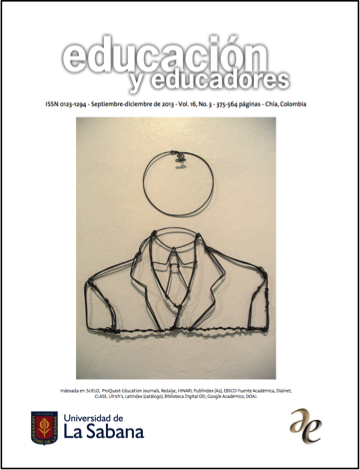Factors Associated with Life at School for Teenagers
Keywords:
Self esteem, student welfare, familiy, educational models, education. (Source, UNESCO Theraurus).Abstract
The article presents the findings of research on the conditions and factors associated with life at school. The purpose was to evaluate school life through a descriptive transversal study conducted at nine schools in five towns in Cundinamarca Colombia during 2011. The participants included 1091 students and 101 teachers. The instruments used included variables such as the climate at school, aggression, risk and support factors, self-esteem, family functionality and subjective well-being. The Precede Proceed educational model was used to diagnose life at school. The students said the climate at school is unsatisfactory and cited the existence of aggressive behavior (verbal and physical), destruction of materials, social isolation and sexual harassment. Standard approaches are used to resolve and address conflicts. Problems are caused by difficult students, lack of respect, discipline and intolerance on the part of teachers. The classroom is where aggression occurs most often. Friends and family intervene in solving conflicts. The teachers reported that students are vulnerable to drug and alcohol consumption, and parental support is not evident. The violence is independent of the type of facility, age, social or economic level, and family background (nuclear or non-nuclear). Unlike the students, the teachers have good self-esteem, family functionality and subjective well-being.Downloads
Download data is not yet available.
Published
2014-01-20
How to Cite
López de Mesa-Melo, C., Carvajal-Castillo, C. A., Urrea-Roa, P. N., & Soto-Godoy, M. F. (2014). Factors Associated with Life at School for Teenagers. Educación Y Educadores, 16(3). Retrieved from https://educacionyeducadores.unisabana.edu.co/index.php/eye/article/view/2716
Issue
Section
Educación escolar
License
1. Proposed Policy for Journals That Offer Open Access
Authors who publish with this journal agree to the following terms:
-
This journal and its papers are published with the Creative Commons License CC BY 4.0 DEED Atribución 4.0 Internacional. You are free to share copy and redistribute the material in any medium or format if you: give appropriate credit, provide a link to the license, and indicate if changes were made; don’t use our material for commercial purposes; don’t remix, transform, or build upon the material.






